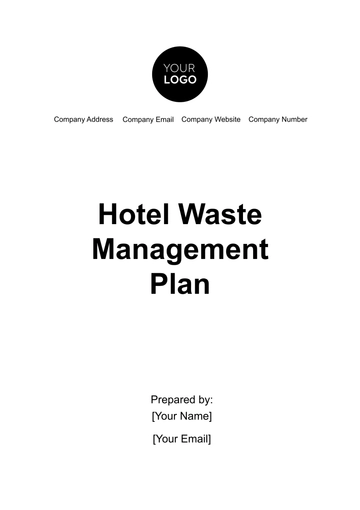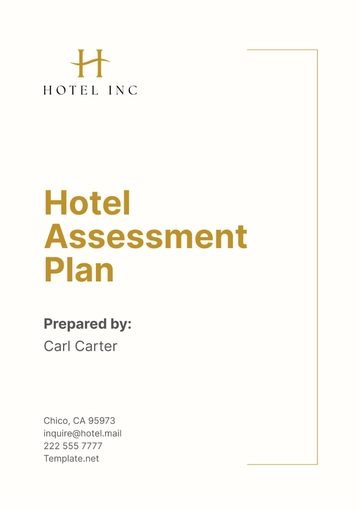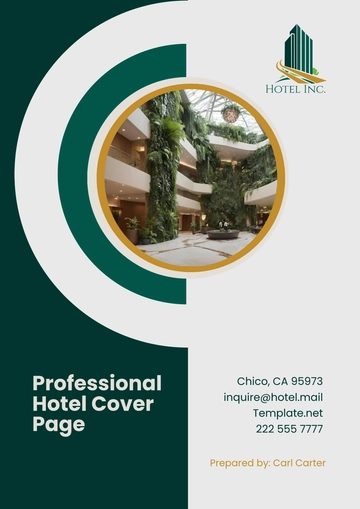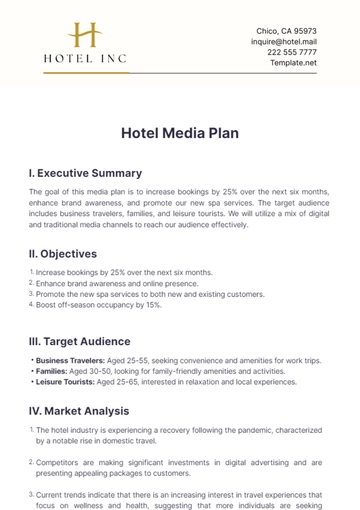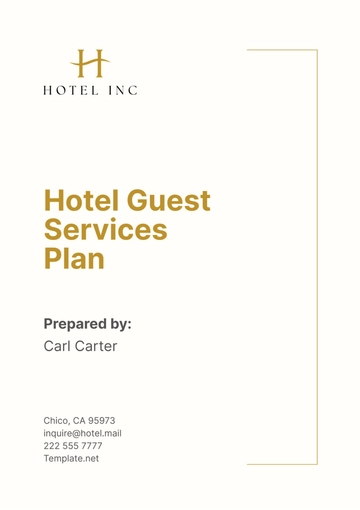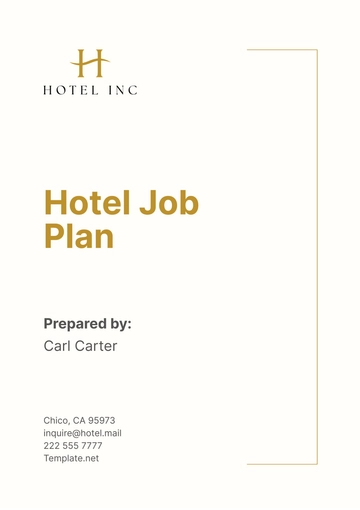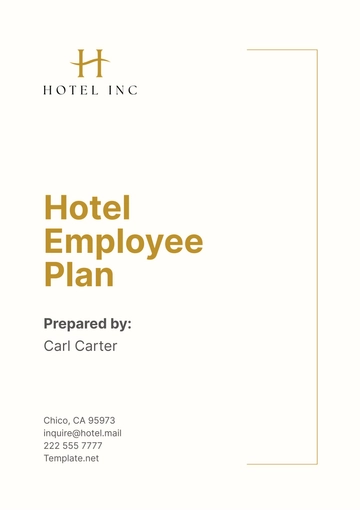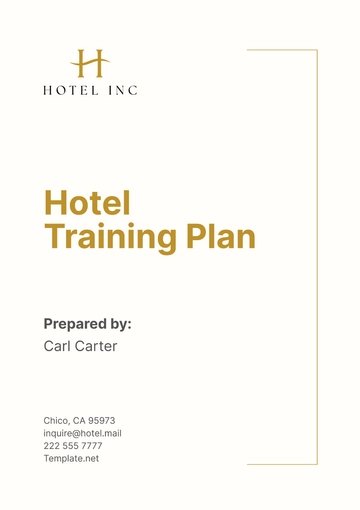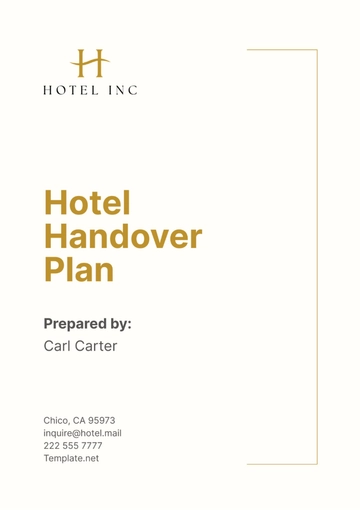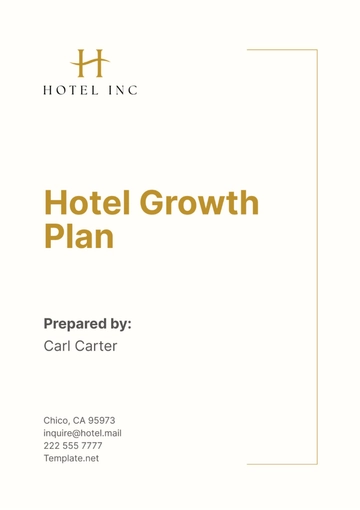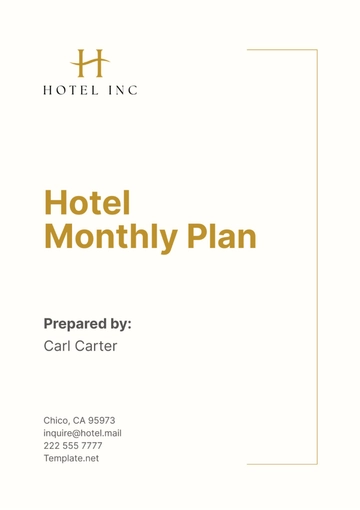Free Hotel Assessment Plan
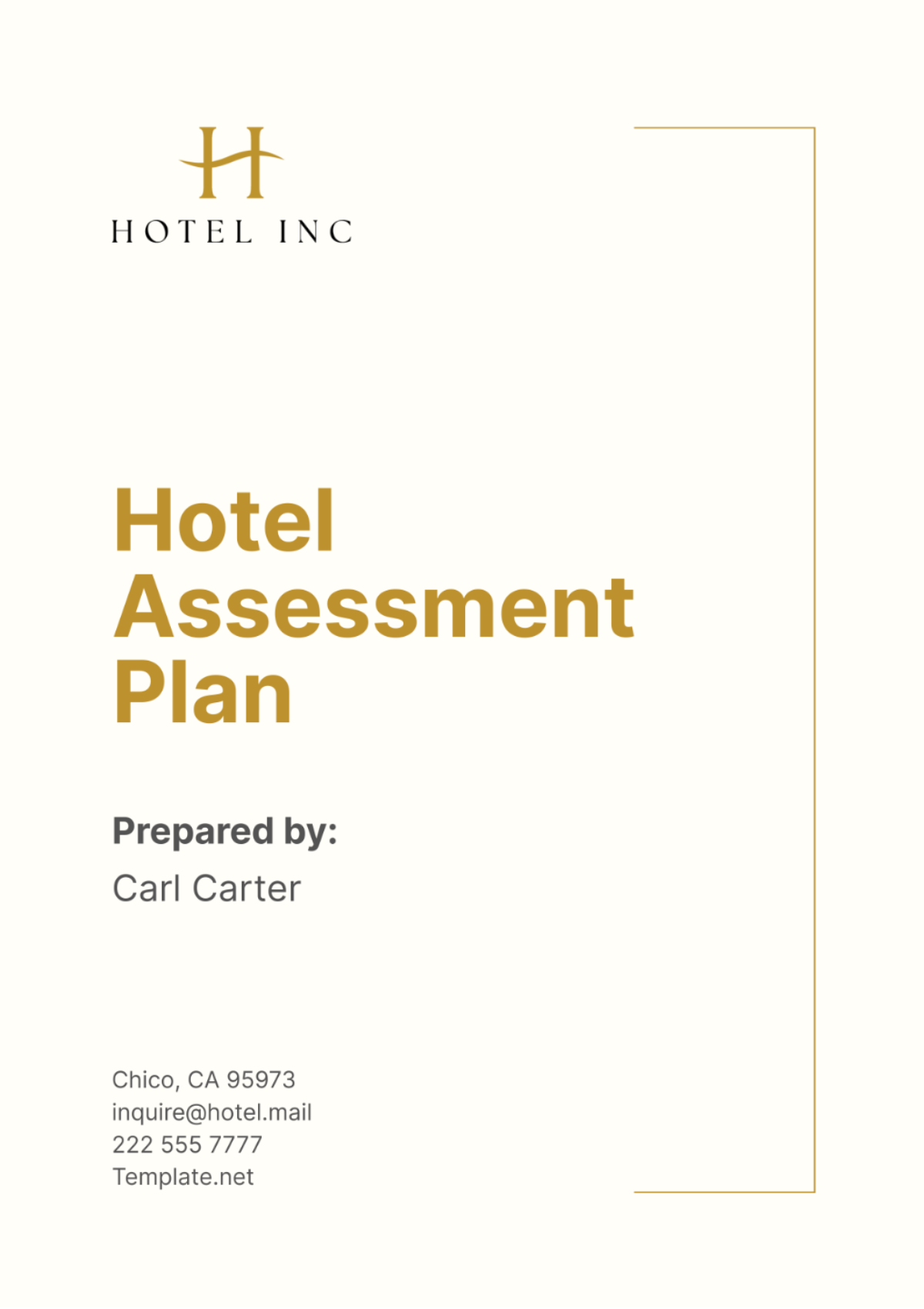
I. Introduction
A. Purpose of the Assessment Plan
The Hotel Assessment Plan serves as a framework to uphold our commitment to excellence in hospitality by systematically evaluating every aspect of our operations. By identifying areas of strength and opportunities for improvement, we aim to consistently enhance the guest experience and maintain our reputation as a premier destination.
B. Overview of the Assessment Process
Our assessment process involves a comprehensive review of service quality, cleanliness, safety, compliance, and guest satisfaction. This structured approach ensures that all facets of the hotel's operations are thoroughly evaluated and aligned with our standards of excellence.
C. Scope and Coverage of the Assessment
The assessment covers all departments and functions within the hotel, including front desk operations, housekeeping, food and beverage services, facilities management, and security. By encompassing every aspect of the guest journey, we ensure a holistic evaluation of the hotel's performance.
II. Assessment Criteria
A. Service Quality
Front Desk Operations
Our assessment of front desk operations focuses on efficiency, accuracy, and guest satisfaction during check-in, check-out, and throughout their stay.
Housekeeping Services
We evaluate the cleanliness, thoroughness, and timeliness of housekeeping services to ensure that guest rooms meet the highest standards of comfort and hygiene.
Concierge Services
The quality of concierge services is assessed based on the knowledge, responsiveness, and helpfulness of staff in assisting guests with various needs and inquiries.
Room Service
Our evaluation of room service encompasses the promptness, accuracy, and presentation of food and beverage offerings, as well as the overall dining experience for guests.
Guest Interaction and Communication
We gauge the effectiveness of staff communication and guest interactions, focusing on friendliness, professionalism, and responsiveness to guest inquiries and requests.
B. Cleanliness and Maintenance
Guest Rooms
Cleanliness and maintenance of guest rooms are assessed to ensure that accommodations meet the highest standards of cleanliness, comfort, and functionality.
Public Areas
We evaluate the cleanliness and upkeep of all public areas, including lobbies, corridors, elevators, and restrooms, to create a welcoming and hygienic environment for guests.
Facilities and Amenities
The cleanliness and functionality of hotel facilities and amenities, such as fitness centers, swimming pools, and recreational areas, are evaluated to enhance the overall guest experience.
Equipment and Infrastructure
Maintenance of essential equipment and infrastructure, including HVAC systems, lighting, plumbing, and in-room amenities, is crucial to ensure guest comfort and safety.
C. Facilities and Amenities
Restaurants and Bars
We assess the quality of food and beverage offerings, service efficiency, and ambiance in our restaurants and bars to provide guests with exceptional dining experiences.
Fitness Center and Spa
The availability, condition, and quality of equipment and services in our fitness center and spa are evaluated to promote guest wellness and relaxation.
Swimming Pool and Recreational Areas
Cleanliness, safety, and availability of amenities in our swimming pool and recreational areas are essential to provide guests with enjoyable leisure experiences.
Meeting and Event Spaces
We assess the functionality, cleanliness, and technical support in our meeting and event spaces to ensure successful gatherings and events for our guests.
Parking and Transportation Services
The accessibility, security, and efficiency of our parking and transportation services are evaluated to facilitate convenient and stress-free arrivals and departures for guests.
III. Assessment Methodology
A. Data Collection Methods
On-site Inspections
Trained assessors conduct thorough on-site inspections using standardized checklists to evaluate all aspects of the hotel's operations and facilities.
Guest Surveys
Feedback from guest surveys, distributed during or after their stay, provides valuable insights into their experiences and satisfaction levels.
Employee Interviews
Interviews with staff members allow us to assess their understanding of procedures, identify training needs, and gather feedback on operational challenges.
Document Review
Reviewing relevant documents such as maintenance logs, cleanliness checklists, and incident reports helps us verify compliance with standards and identify areas for improvement.
B. Assessment Tools and Checklists
Standardized Evaluation Forms
Assessors use predefined evaluation forms tailored to each area of assessment to ensure consistency and thoroughness in data collection.
Performance Metrics and KPIs
Key performance indicators such as guest satisfaction scores, cleanliness ratings, and service response times are tracked to measure progress and identify trends.
Mystery Shopper Programs
Anonymous guests are enlisted to evaluate service quality and adherence to standards, providing unbiased feedback on the guest experience.
Quality Assurance Software
Technology platforms streamline data collection, analysis, and reporting processes, allowing for efficient monitoring of performance and identification of improvement opportunities.
IV. Assessment Schedule
A. Frequency of Assessments
Assessments are systematically carried out at regular intervals over the course of the entire year. The frequency and timing of these assessments are carefully determined by taking into account both the operational needs unique to the organization and the industry standards that govern best practices.
B. Timing and Duration of Assessments
Assessments are generally conducted during times when guest activity is at a lower level to reduce any potential disturbances to their experiences. The length of these assessments can differ significantly based on the extent and depth of the evaluation that needs to be carried out.
C. Pre-assessment Preparation
The members of the staff are given detailed briefings regarding the entire assessment process. Additionally, all necessary preparations are meticulously carried out to ensure that everything is in a state of readiness. These preparations encompass a range of activities, including comprehensive training sessions for the staff, thorough maintenance checks on all relevant equipment and facilities, and rigorous inspections to ensure that cleanliness standards are upheld.
D. Post-assessment Review and Reporting
After conducting the initial assessments, the gathered data and findings are meticulously compiled into comprehensive reports. These reports are then thoroughly analyzed to extract meaningful insights. The analyzed information is subsequently shared with all relevant stakeholders to ensure transparency and collaborative engagement.
Based on the insights and identified areas requiring enhancement, detailed action plans are formulated to address specific issues. The implementation of these action plans is closely monitored, with regular reviews and follow-ups conducted to track progress and make necessary adjustments. This systematic process ensures continuous improvement and effective resolution of the identified problems.
V. Roles and Responsibilities
A. General Manager
The General Manager oversees the entire assessment process, ensuring that it aligns with the hotel's objectives and standards. They provide leadership and support to department heads and staff members, facilitating a collaborative approach to continuous improvement.
B. Department Heads
Department heads are responsible for implementing the assessment plan within their respective areas of responsibility. They coordinate with their teams to ensure compliance with standards, address identified issues, and drive performance improvement initiatives.
C. Quality Assurance Team
If the hotel has a dedicated quality assurance team, they play a crucial role in developing, implementing, and monitoring the assessment plan. They conduct audits, analyze data, and provide recommendations for enhancing operational efficiency and guest satisfaction.
D. External Auditors or Inspectors
In some cases, external auditors or inspectors may be involved in the assessment process to provide an independent evaluation of the hotel's performance. They bring expertise and impartiality to the assessment, validating internal findings and providing benchmarking insights.
VI. Training and Development
A. Staff Training Programs
Continuous training programs are implemented on a regular basis to make certain that all staff members comprehend and strictly follow the established standards and procedures. These training sessions are designed to provide thorough instruction on a variety of topics crucial to their roles.
The subject matter for these training programs can cover a wide range of areas, including but not limited to, customer service skills, which are essential for maintaining high levels of client satisfaction; safety protocols, which ensure the well-being and security of both staff and patrons; and technical competencies, which are necessary for staff to effectively perform specific tasks and responsibilities associated with their positions. Each of these areas is carefully chosen to align with the overarching goals of the organization and to enhance the overall proficiency and effectiveness of the staff.
B. Performance Improvement Plans
Performance improvement plans are formulated specifically for those staff members who need extra assistance in order to meet the established performance expectations. These comprehensive plans meticulously detail the specific objectives that the employees need to achieve, the timeframes within which these objectives should be met, and the various support mechanisms that will be provided to assist them. The ultimate goal of these plans is to ensure that the employees receive ample guidance and resources to help them succeed in their respective roles within the organization.
C. Continuous Learning and Development Initiatives
The hotel actively fosters an environment where continuous learning and professional development are highly encouraged and valued. It provides numerous opportunities for its staff members to grow and improve their skills and knowledge. These opportunities may encompass a variety of resources and programs. For instance, employees might have access to online training modules that cover a wide array of topics relevant to their roles.
Additionally, the hotel may organize workshops and seminars, allowing staff to engage in more hands-on, interactive learning experiences. Furthermore, the hotel supports career development through specialized programs designed to help staff advance to higher positions within the organization. Overall, the commitment to continuous learning is evident in the diverse and comprehensive range of educational opportunities available to all employees.
VII. Communication and Feedback
A. Internal Communication Channels
In order to ensure that all staff members are thoroughly informed about the assessment process, the findings that emerge from these assessments, and the subsequent plans of action, comprehensive measures are in place to promote open and transparent communication channels. These measures include a variety of communication methods designed to disseminate information clearly and effectively. Regularly scheduled meetings provide a structured forum for direct and immediate exchange of information, allowing staff to ask questions and receive answers in real-time.
Additionally, newsletters are circulated on a consistent basis to summarize key points and updates, ensuring everyone remains in the loop even if they are unable to attend the meetings. Furthermore, digital communication platforms are utilized to enable instant and accessible communication, fostering a sense of connectivity among the team. These platforms allow for the sharing of documents, feedback, and real-time updates. Collectively, these strategies facilitate a seamless flow of information and contribute to a collaborative work environment where all staff members feel engaged and informed.
B. Feedback Mechanisms for Guests and Employees
There are established feedback mechanisms designed to gather input from both guests and employees about their experiences and suggestions for improvement. To collect this valuable feedback, several methods are employed, including surveys, suggestion boxes, one-on-one meetings, and other channels. The information gathered through these various means is then used to inform decision-making and to guide initiatives aimed at enhancing overall performance and satisfaction.
C. Reporting Structure for Assessment Findings
The findings from the assessment are meticulously documented and subsequently communicated to all relevant stakeholders. This group of stakeholders includes senior management, department heads, and frontline staff. The reports generated from the assessment contain detailed information highlighting the strengths identified, areas that require improvement, and specific action plans. These comprehensive reports are designed to serve as a guiding roadmap for driving and facilitating continuous performance improvement across the organization.
VIII. Continuous Improvement
A. Action Plans for Addressing Identified Areas of Improvement
Action plans are developed to address identified areas for improvement, outlining specific initiatives, responsibilities, timelines, and success metrics. These action plans are implemented collaboratively across departments to drive continuous improvement in performance and guest satisfaction.
B. Monitoring and Tracking Progress
Progress against action plans is monitored regularly through performance metrics, KPIs, and follow-up assessments. Feedback mechanisms are used to solicit input from stakeholders and adjust strategies as needed to ensure effective implementation and achievement of goals.
C. Review and Revision of Assessment Criteria and Processes
The assessment criteria and processes are periodically reviewed and revised to ensure their relevance, effectiveness, and alignment with evolving guest expectations and industry standards. Input from stakeholders, industry benchmarks, and best practices inform the review process to drive continuous improvement.
IX. Conclusion
A. Summary of Key Points
The Hotel Assessment Plan serves as a strategic framework for maintaining and enhancing the hotel's performance and guest satisfaction. By systematically evaluating all aspects of operations, implementing targeted improvement initiatives, and fostering a culture of continuous improvement, we strive to exceed guest expectations and achieve excellence in hospitality.
B. Commitment to Excellence and Continuous Improvement
We are committed to upholding the highest standards of quality, safety, and service excellence in everything we do. Our dedication to continuous improvement ensures that we remain at the forefront of the hospitality industry, delivering memorable experiences that exceed guest expectations.
C. Acknowledgment of Stakeholder Contributions
We extend our sincere appreciation to all stakeholders, including guests, employees, management, and external partners, for their contributions to the assessment process. Together, we are committed to achieving our shared goal of excellence in hospitality and creating unforgettable experiences for our guests.
- 100% Customizable, free editor
- Access 1 Million+ Templates, photo’s & graphics
- Download or share as a template
- Click and replace photos, graphics, text, backgrounds
- Resize, crop, AI write & more
- Access advanced editor
Manage your hotel's performance with ease using the Hotel Assessment Plan Template from Template.net. This editable and customizable template features an intuitive AI Editor Tool, allowing you to tailor assessment criteria to your specific needs. Ensure excellence in service, cleanliness, and safety with this comprehensive tool designed to streamline your assessment process.
You may also like
- Finance Plan
- Construction Plan
- Sales Plan
- Development Plan
- Career Plan
- Budget Plan
- HR Plan
- Education Plan
- Transition Plan
- Work Plan
- Training Plan
- Communication Plan
- Operation Plan
- Health And Safety Plan
- Strategy Plan
- Professional Development Plan
- Advertising Plan
- Risk Management Plan
- Restaurant Plan
- School Plan
- Nursing Home Patient Care Plan
- Nursing Care Plan
- Plan Event
- Startup Plan
- Social Media Plan
- Staffing Plan
- Annual Plan
- Content Plan
- Payment Plan
- Implementation Plan
- Hotel Plan
- Workout Plan
- Accounting Plan
- Campaign Plan
- Essay Plan
- 30 60 90 Day Plan
- Research Plan
- Recruitment Plan
- 90 Day Plan
- Quarterly Plan
- Emergency Plan
- 5 Year Plan
- Gym Plan
- Personal Plan
- IT and Software Plan
- Treatment Plan
- Real Estate Plan
- Law Firm Plan
- Healthcare Plan
- Improvement Plan
- Media Plan
- 5 Year Business Plan
- Learning Plan
- Marketing Campaign Plan
- Travel Agency Plan
- Cleaning Services Plan
- Interior Design Plan
- Performance Plan
- PR Plan
- Birth Plan
- Life Plan
- SEO Plan
- Disaster Recovery Plan
- Continuity Plan
- Launch Plan
- Legal Plan
- Behavior Plan
- Performance Improvement Plan
- Salon Plan
- Security Plan
- Security Management Plan
- Employee Development Plan
- Quality Plan
- Service Improvement Plan
- Growth Plan
- Incident Response Plan
- Basketball Plan
- Emergency Action Plan
- Product Launch Plan
- Spa Plan
- Employee Training Plan
- Data Analysis Plan
- Employee Action Plan
- Territory Plan
- Audit Plan
- Classroom Plan
- Activity Plan
- Parenting Plan
- Care Plan
- Project Execution Plan
- Exercise Plan
- Internship Plan
- Software Development Plan
- Continuous Improvement Plan
- Leave Plan
- 90 Day Sales Plan
- Advertising Agency Plan
- Employee Transition Plan
- Smart Action Plan
- Workplace Safety Plan
- Behavior Change Plan
- Contingency Plan
- Continuity of Operations Plan
- Health Plan
- Quality Control Plan
- Self Plan
- Sports Development Plan
- Change Management Plan
- Ecommerce Plan
- Personal Financial Plan
- Process Improvement Plan
- 30-60-90 Day Sales Plan
- Crisis Management Plan
- Engagement Plan
- Execution Plan
- Pandemic Plan
- Quality Assurance Plan
- Service Continuity Plan
- Agile Project Plan
- Fundraising Plan
- Job Transition Plan
- Asset Maintenance Plan
- Maintenance Plan
- Software Test Plan
- Staff Training and Development Plan
- 3 Year Plan
- Brand Activation Plan
- Release Plan
- Resource Plan
- Risk Mitigation Plan
- Teacher Plan
- 30 60 90 Day Plan for New Manager
- Food Safety Plan
- Food Truck Plan
- Hiring Plan
- Quality Management Plan
- Wellness Plan
- Behavior Intervention Plan
- Bonus Plan
- Investment Plan
- Maternity Leave Plan
- Pandemic Response Plan
- Succession Planning
- Coaching Plan
- Configuration Management Plan
- Remote Work Plan
- Self Care Plan
- Teaching Plan
- 100-Day Plan
- HACCP Plan
- Student Plan
- Sustainability Plan
- 30 60 90 Day Plan for Interview
- Access Plan
- Site Specific Safety Plan


